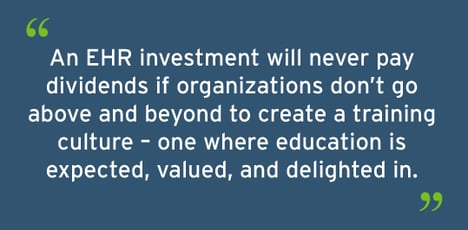Last week, HIStalk’s Dr. Jayne published a great editorial on the problems with EHR training. She called out a few of the problems she sees consistently, from unqualified trainers to irrelevant lessons to phoned-in tactics.
These problems are certainly present in some organizations, but I believe they are symptoms of a larger issue.
The bigger issue is that many organizations view education as a singular event, not an ongoing effort – and that means they don’t invest the time and money to realize the benefits of comprehensive education.
All other issues, from poorly planned programs to inadequate educators, stem from the expectation that training should be quick, cheap, and one-time-only.
This expectation explains why some organizations don’t tailor their programs: It’s time-consuming and costly to provide different training options to the same group of people.
It accounts for the lack of qualified trainers: When organizations relegate less-qualified people to training roles, they inevitably end up with a poor classroom experience.
And it explains low buy-in: When organizations don’t verify their training’s return on investment and share that return across the organization, they end up with unattended webinars and training sessions full of people checking their phones.
This problem isn’t universal to healthcare organizations, and many organizations have made immense strides in developing training cultures within their walls. But for those that haven’t, an EHR investment will never pay dividends if they don’t go above and beyond to create a training culture – one where education is expected, valued, and even delighted in.
 For organizations that really succeed in training, their first step is often in measuring and sharing the value of education across the organization.
For organizations that really succeed in training, their first step is often in measuring and sharing the value of education across the organization.
At Nordic, we are working to provide metrics that clearly tie training to increased provider efficiency and satisfaction. We believe that if organizations spend time designing training that results in tangible benefits – and then show those benefits to providers – providers are more likely to show up and participate.
The second step is a comprehensive, ongoing education strategy that goes beyond mandatory classroom hours and occasional tip sheets.
I’ve noticed that successful organizations tend to ask the following questions as they plan:
- How do my end users, analysts, and educators communicate? When organizations excel at training, they usually have a feedback loop that informs trainers when end users are struggling and need to be re-educated. Sometimes this takes the shape of clinical informaticists, who use their close relationships with providers to pass on information to analysts and trainers. Other organizations have trainers do rounding, to understand how end users are using the system.
- Who are we putting in charge of education and curriculum planning? Not every EHR expert is qualified to train others. Developing a lesson plan involves a deep level of thought on how to engage providers, keep them interested, and take advantage of every single precious minute. This means investing in trainers with education backgrounds, paying them a competitive wage, and dedicating their time entirely to training (rather than creating trainer/analyst roles where analysis usually takes precedent).
- How are we measuring ROI, demonstrating the value proposition, and setting expectations? To ensure buy-in from leadership and end users, organizations need to understand how training benefits them and then demonstrate those results – whether it’s saving two minutes per patient per day or creating a more efficient organization long-term. In addition to the value prop, it’s also important to set expectations on what training will entail. In her editorial, Dr. Jayne describes a classroom where providers are forced to replicate a workflow they will never use. With tight budgets, sometimes this is a reality of training. The important thing is to explain up front, “This workflow may not look like your day-to-day workflows, but the SmartTool you’ll be using is the same and will benefit you immensely."
An EHR is an immense investment for a healthcare organization, but if providers hate using it, the investment will never result in the level of care, efficiency, and satisfaction that it could.
Invest in building a training culture as well. I guarantee that long-term, you will be glad you did.
Lauren Griessmeyer has 11 years of experience in EHR training and currently serves as a practice director in Consulting Services for Nordic. Check out the video below to learn what fascinates her about her job: